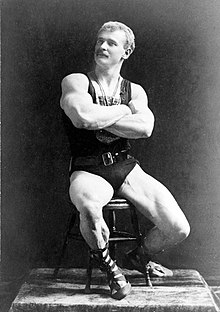Eugen Sandow
Eugen Sandow or Eugene Sandow (born April 2, 1867 in Koenigsberg , East Prussia , as Friedrich Wilhelm Müller ; † October 14, 1925 in London , Great Britain ) was a pioneer of strength sports , especially bodybuilding .
Life
Sandow was born on April 2, 1867 in Königsberg. He later claimed to be the son of a German father and Russian mother who wanted him to become a Lutheran pastor. According to another version, which his lawyer submitted when he applied for British citizenship in 1906, he is said to have been the illegitimate son of Wilhelmina Elisabeth Kresand, who died in 1876, and who grew up with adoptive parents.
Sandow left Prussia in 1885 to evade military service and traveled through Europe.
Sandow made weight training popular by staging his own shows on stages, which he called "Muscle Display" and in which he a. a. a horse hoisted. Soon he was performing all over Europe, choosing a stage name that was easy to pronounce in all major European languages. On June 6, 1893, he arrived as an “artist” in Ellis Island and a year later toured the USA with the artistic cyclist Nick Kaufmann , where he was also very successful. On May 18, 1894, he shot the film " Sandow " named after him in the Black Maria Studios .
Sandow also hosted the first major bodybuilding competition held on September 14, 1901 at London's Royal Albert Hall under the title "The Great Competition". Twelve participants competed for the honor of winning this competition. Third place received a bronze statue by Eugene Sandow, a copy of which has been presented to the winner of the Mr. Olympia competition since 1977 . He returned to the USA on October 3, 1903.
Sandow was married with two daughters and died in London in 1925, where he is also buried. There are two variants in circulation about the cause of death: The first variant says that he died of a cerebral haemorrhage that he suffered when he pushed up a car to save a child who had an accident underneath. The second variant, which explains the probable cause of death, treats Sandow's syphilis disease, the late stage of which was still incurable at the time. His grave in Putney Vale Cemetery in the London Borough of Wandsworth was left without a tombstone at the request of his wife Blanche; a black marble tomb was only erected in 2002.
Sandow participated in the funding of the Australian polar explorer Douglas Mawson led Australasian Antarctic Expedition (1911-1914). In return , Mawson named Mount Sandow after him, a nunatak in Queen Marie Land in East Antarctica . A small town in Texas also bears his name.
Meaning of Eugen Sandow
While the physical exercises had been instrumentalized for an external purpose, e.g. B. in the sense of exercise therapy , sport or fitness for the military , Sandow, a body cult based on the ideal of beauty , was initially based on the ideal of beauty of antiquity because of the nudity associated with it . Ancient statues were measured to get equal muscle proportions.
Works
- Eugen Sandow: Strength and how to get it. Translated from English by Gustav Möckel. Kraft und Schönheit, Berlin 1904. Reprint: Edition Libri Rari published by Th. Schäfer, Hanover 1993, ISBN 3-88746-289-0 .
literature
- Friedhelm Beuker : Sandow, Eugen. In: New German Biography (NDB). Volume 22, Duncker & Humblot, Berlin 2005, ISBN 3-428-11203-2 , p. 423 ( digitized version ).
- David Chapman: Eugen Sandow and the Birth of Bodybuilding. In: Hardgainer . May 1993.
- David Chapman: Sandow the Magnificent: Eugen Sandow and the Beginnings of Bodybuilding . University of Illinois Press, Champaign, IL 1994 (Reprint: 2006, ISBN 0-252-07306-1 ).
Web links
- Literature by and about Eugen Sandow in the catalog of the German National Library
- Peter-Philipp Schmitt: Eugen Sandow: The father of bodybuilding , Frankfurter Allgemeine Zeitung, April 2, 2017.
- Gesche Sager: Eugen Sandow: Brute eroticism . February 3, 2008 ( Spiegel Online ).
Individual evidence
- ^ David Waller: The Perfect Man: The Muscular Life and Times of Eugen Sandow, Victorian Strongman . Victorian Secrets, Brighton 2011, ISBN 978-1-906469-25-2 , pp. 16 f.
- ^ A b Eugene Sandow , information on the website ellisisland.org (registration required, accessed October 9, 2011).
- ^ Mawson, Douglas: The Home of the Blizzard. William Heinemann, London 1915 (reprinted 2002), p. XIX (accessed October 25, 2017).
- ↑ Bertrand, Kenneth J. and Alberts, Fred G .: Geographic Names of Antarctica. US Govt. Print. Off., Washington 1956, p. 271. (accessed October 9, 2011).
- ^ Sandow, TX , information on texasescapes.com (accessed October 9, 2011).
- ↑ Sandow, TX , map of the village of Sandow on mapquest.com (accessed October 9, 2011).
- ↑ Arnd Krüger : History of movement therapy. In: Preventive Medicine . Springer loose leaf collection, Heidelberg 1999, 07.06, 1–22.
- ↑ Arnd Krüger, Bernd Wedemeyer (Hrsg.): Kraftkörper - Körperkraft: To understand physical culture and fitness yesterday and today. Booklet accompanying the exhibition in the entrance hall of the new university library; 3.7. - July 31, 1995. Göttingen: SUB 1995, ISBN 3-930457-06-7 .
- ↑ http://www.military.com/military-fitness/fitness-test-prep/weights-and-pt-workouts
- ↑ http://www.spiegel.tv/filme/extremer-koerperkult/
| personal data | |
|---|---|
| SURNAME | Sandow, Eugene |
| ALTERNATIVE NAMES | Müller, Friedrich Wilhelm |
| BRIEF DESCRIPTION | German strength athlete and founder of bodybuilding |
| DATE OF BIRTH | April 2, 1867 |
| PLACE OF BIRTH | Koenigsberg , East Prussia |
| DATE OF DEATH | October 14, 1925 |
| Place of death | London , England |
